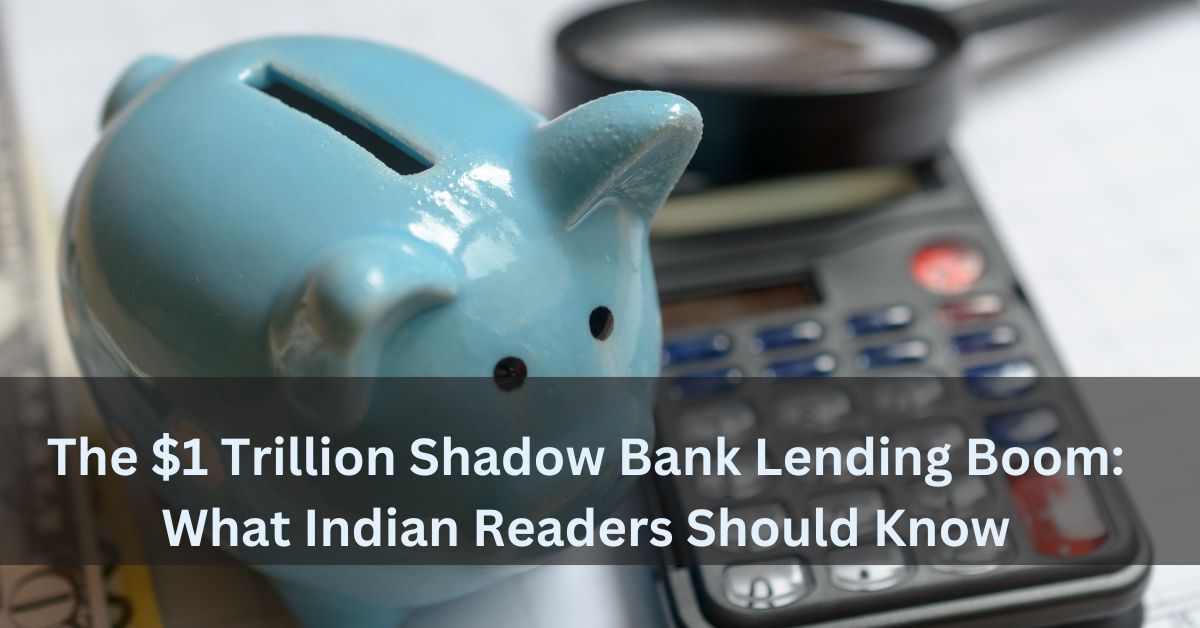The $1 Trillion Shadow Bank Lending Boom: What Indian Readers Should Know
You’ve probably heard about banks giving out loans. But what if loans are given by companies that aren’t actually banks? That’s where shadow banking comes in.
Shadow banks are financial companies that do many of the things regular banks do—like giving loans—but they are not regular banks. They don’t take deposits from the public. These could be private lenders, investment funds, or finance companies. In India, many NBFCs (Non-Banking Financial Companies) work this way.
In recent years, this type of lending has grown very fast—especially in countries like the United States. According to global news sources, lending by these shadow banks has now crossed $1 trillion in value. That’s a huge number, and it’s catching the attention of experts, investors, and regulators everywhere, including in India.
Let’s break this down in simple terms with help from Tech Bullion, so you can understand what’s happening and why it matters.
Why Are Banks Lending to Shadow Banks?
You may ask, “Why would a regular bank lend money to a non-bank?” There are a few reasons:
- Fewer Rules: Lending to shadow banks sometimes means fewer restrictions compared to lending directly to businesses. So, banks find it easier and faster.
- Better Returns: Shadow banks often deal in loans with slightly higher interest rates. If the bank lends money to them, they can earn more compared to giving loans to big, well-known businesses.
- Lower Risk on Paper: These loans are often structured in a way that looks safe. There’s usually some form of security or guarantee.
So in simple words, banks are using shadow banks as middlemen. They pass on the money, and the shadow banks pass it to the borrowers.
What Does This Mean for the Indian Market?
Now, while the trillion-dollar boom is happening in the U.S., India is seeing a similar pattern on a smaller scale.
In India, we have many NBFCs—companies that give loans without being banks. Some big names include Bajaj Finance, Muthoot Finance, and Shriram Finance. They provide loans for everything from two-wheelers to gold to small business needs.
Here’s what’s happening:
- NBFCs Are Filling Gaps: Sometimes banks are slow to lend or avoid certain types of borrowers. NBFCs step in and give those loans, especially in rural and semi-urban areas.
- Banks Are Funding NBFCs: Just like in the U.S., Indian banks are also giving money to NBFCs, which then pass it to end-users.
- People Are Borrowing More: From personal loans to consumer loans, NBFCs have made credit easier to access.
This has helped many individuals and small businesses. But, like all good things, it also comes with some challenges.
What Are the Risks?
While shadow banks make credit more available, they also bring some concerns. Let’s look at a few of them in simple words.
1. Less Supervision
Banks in India are tightly regulated by the Reserve Bank of India (RBI). But NBFCs don’t face the same level of checking. This means mistakes or misuse of funds can go unnoticed for a long time.
2. More Debt in the System
Easier loans mean more people are taking credit. If not managed well, this can lead to problems—especially if people are unable to repay their loans.
3. Chain Reaction Risk
If one big NBFC fails, it can affect the banks that gave them money. This creates a chain reaction in the financial system.
What Has RBI Done About It?
The Reserve Bank of India knows that shadow banking is growing. It has taken steps to make things safer:
- It has started treating large NBFCs more like banks when it comes to rules and checks.
- It has also created a layered system—where bigger NBFCs face stricter norms, and smaller ones follow lighter rules.
- It is working on better data collection and monitoring to catch early signs of trouble.
So, while the RBI is not stopping NBFCs from growing, it is keeping an eye on them to protect the financial system.
What Does This Mean for Indian Borrowers?
For most people, this boom means easier access to loans—whether for buying a fridge on EMI, paying school fees, or starting a small business.
But borrowers should also be careful. Here are a few tips from Tech Bullion:
- Read the loan agreement clearly before signing.
- Compare interest rates between banks and NBFCs.
- Do not take multiple loans at the same time.
- Make sure you understand the total cost of borrowing—not just the monthly EMI.
Is This Boom Good or Bad?
It’s not black and white. There are both good and bad sides.
The good part:
- More people and businesses can get loans quickly.
- NBFCs reach places where big banks don’t go.
- Customers have more options.
The bad part:
- Too much lending without proper checks can cause financial stress.
- Small borrowers might get trapped in high-interest loans.
- If something goes wrong with a big NBFC, many others could be affected too.
That’s why the RBI is being careful, and people are being advised to borrow smartly.
Final Thoughts
The $1 trillion shadow banking boom may be happening mostly in the U.S., but the idea is spreading fast in India too. NBFCs and other non-bank lenders are becoming a major part of how loans are given in our country.
While this helps many people get credit, it also calls for careful planning, good rules, and smart decisions—both from borrowers and lenders.
To stay updated on the latest in loans, credit, and Indian financial news, keep visiting Tech Bullion. We make money talk simply, just the way it should be.







